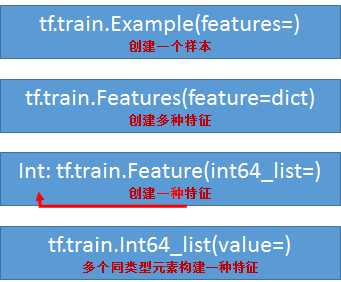TFRecord 是 tensorflow 内置的文件格式,它是一种二进制文件,具有以下优点:
1. 统一各种输入文件的操作
2. 更好的利用内存,方便复制和移动
3. 将二进制数据和标签(label)存储在同一个文件中
引言
在了解如下操作后进一步详细讲解TFRecord
tf.train.Int64List(value=list_data)
它的作用是 把 list 中每个元素转换成 key-value 形式,
注意,输入必须是 list,且 list 中元素类型要相同,且与 Int 保持一致;
# value = tf.constant([1, 2]) ### 这会报错的 ss = 1 ### Int64List 对应的元素只能是 int long,其他同理 tt = 2 out1 = tf.train.Int64List(value = [ss, tt]) print(out1) # value: 1 # value: 2 ss = [1 ,2] out2 = tf.train.Int64List(value = ss) print(out2) # value: 1 # value: 2
同类型的 方法还有 2 个
tf.train.FloatList
tf.train.BytesList
tf.train.Feature(int64_list=)
它的作用是 构建 一种类型的特征集,比如 整型
out = tf.train.Feature(int64_list=tf.train.Int64List(value=[33, 22])) print(out) # int64_list { # value: 33 # value: 22 # }
也可以是其他类型
tf.train.Feature(float_list=tf.train.FloatList())
tf.train.Feature(bytes_list=tf.train.BytesList())
tf.train.Features(feature=dict_data)
它的作用是 构建 多种类型 的特征集,可以 dict 格式表达 多种类型
ut = tf.train.Features(feature={ "suibian": tf.train.Feature(int64_list=tf.train.Int64List(value=[1, 2, 4])), "a": tf.train.Feature(float_list=tf.train.FloatList(value=[5., 7.])) }) print(out) # feature { # key: "a" # value { # float_list { # value: 5.0 # value: 7.0 # } # } # } # feature { # key: "suibian" # value { # int64_list { # value: 1 # value: 2 # value: 4 # } # } # }
tf.train.Example(features=tf.train.Features())
它的作用是创建一个 样本,Example 对应一个样本
example = tf.train.Example(features= tf.train.Features(feature={ ‘a‘: tf.train.Feature(int64_list=tf.train.Int64List(value=range(2))), ‘b‘: tf.train.Feature(bytes_list=tf.train.BytesList(value=[b‘m‘,b‘n‘])) })) print(example) # features { # feature { # key: "a" # value { # int64_list { # value: 0 # value: 1 # } # } # } # feature { # key: "b" # value { # bytes_list { # value: "m" # value: "n" # } # } # } # }
一幅图总结一下上面的代码

Example 协议块
它其实是一种 数据存储的 格式,类似于 xml、json 等;
用上述方法实现该格式;
一个 Example 协议块对应一个样本,一个样本有多种特征,每种特征下有多个元素,可参看上图;
message Example{ Features features = 1; } message Features{ map<string,Features> feature = 1; } message Feature { oneof kind { BytesList bytes_list = 1; FloateList float_list = 2; Int64List int64_list = 3; } }
TFRecord 文件就是以 Example协议块 格式 存储的;
TFRecord 文件
该类文件具有写功能,且可以把其他类型的文件转换成该类型文件,其实相当于先读取其他文件,再写入 TFRecord 文件;
该类文件也具有读功能;
TFRecord 存储
存储分两步:
1.建立存储器
2. 构造每个样本的 Example 协议块
tf.python_io.TFRecordWriter(file_name)
构造存储器,存储器有两个常用方法
- write(record):向文件中写入一个样本
- close():关闭存储器
注意:此处的 record 为一个序列化的 Example,通过 Example.SerializeToString()来实现,它的作用是将 Example 中的 map 压缩为二进制,节约大量空间
示例代码1:将 MNIST 数据集保存成 TFRecord 文件
import tensorflow as tf import numpy as np import input_data # 生成整数型的属性 def _int64_feature(value): return tf.train.Feature(int64_list = tf.train.Int64List(value = [value])) # 生成字符串类型的属性,也就是图像的内容 def _string_feature(value): return tf.train.Feature(bytes_list = tf.train.BytesList(value = [value])) # 读取图像数据 和一些属性 mniset = input_data.read_data_sets(‘../../../data/MNIST_data‘,dtype=tf.uint8, one_hot=True) images = mniset.train.images labels = mniset.train.labels pixels = images.shape[1] # (55000, 784) num_examples = mniset.train.num_examples # 55000 file_name = ‘output.tfrecords‘ ### 文件名 writer = tf.python_io.TFRecordWriter(file_name) ### 写入器 for index in range(num_examples): ### 遍历样本 image_raw = images[index].tostring() ### 图片转成 字符型 example = tf.train.Example(features = tf.train.Features(feature = { ‘pixel‘: _int64_feature(pixels), ‘label‘: _int64_feature(np.argmax(labels[index])), ‘image_raw‘: _string_feature(image_raw) })) writer.write(example.SerializeToString()) ### 写入 TFRecord writer.close()
示例代码2:将 csv 保存成 TFRecord 文件
train_frame = pd.read_csv("../myfiles/xx3.csv") train_labels_frame = train_frame.pop(item="label") train_values = train_frame.values train_labels = train_labels_frame.values print("values shape: ", train_values.shape) # values shape: (2, 3) print("labels shape:", train_labels.shape) # labels shape: (2,) writer = tf.python_io.TFRecordWriter("xx3.tfrecords") for i in range(train_values.shape[0]): image_raw = train_values[i].tostring() example = tf.train.Example( features=tf.train.Features( feature={ "image_raw": tf.train.Feature(bytes_list=tf.train.BytesList(value=[image_raw])), "label": tf.train.Feature(int64_list=tf.train.Int64List(value=[train_labels[i]])) } ) ) writer.write(record=example.SerializeToString()) writer.close()
示例3:将 png 文件保存成 TFRecord 文件
# filenames = tf.train.match_filenames_once(‘../myfiles/*.png‘) filenames = glob.iglob(‘..\myfiles\*.png‘) writer = tf.python_io.TFRecordWriter(‘png.tfrecords‘) for filename in filenames: img = Image.open(filename) img_raw = img.tobytes() label = 1 example = tf.train.Example( features=tf.train.Features( feature={ "image_raw": tf.train.Feature(bytes_list=tf.train.BytesList(value=[img_raw])), "label": tf.train.Feature(int64_list=tf.train.Int64List(value=[label])) } ) ) writer.write(record=example.SerializeToString()) writer.close()
TFRecord 读取
读取文件 和 tensorflow 读取数据方法类似,参考我的博客 读取数据
tf.TFRecordReader()
建立读取器,有 read 和 close 方法
tf.parse_single_example(serialized,features=None,name= None)
解析单个 Example 协议块
- serialized : 标量字符串的Tensor,一个序列化的Example,文件经过文件阅读器之后的value
- features :字典数据,key为读取的名字,value为FixedLenFeature
- return : 一个键值对组成的字典,键为读取的名字
features中的value还可以为tf.VarLenFeature(),但是这种方式用的比较少,它返回的是SparseTensor数据,这是一种只存储非零部分的数据格式,了解即可。
tf.FixedLenFeature(shape,dtype)
- shape : 输入数据的形状,一般不指定,为空列表
- dtype : 输入数据类型,与存储进文件的类型要一致,类型只能是float32,int 64, string
- return : 返回一个定长的 Tensor (即使有零的部分也存储)
示例代码
filename = ‘png.tfrecords‘ file_queue = tf.train.string_input_producer([filename], shuffle=True) reader = tf.TFRecordReader() key, value = reader.read(file_queue) ### features 的 key 必须和 写入时 一致,数据类型也必须一致,shape 可为 空 dict_data= tf.parse_single_example(value, features={‘label‘: tf.FixedLenFeature(shape=(1,1), dtype=tf.int64), ‘image_raw‘: tf.FixedLenFeature(shape=(), dtype=tf.string)}) label = tf.cast(dict_data[‘label‘], tf.int32) img = tf.decode_raw(dict_data[‘image_raw‘], tf.uint8) ### 将 string、bytes 转换成 int、float image_tensor = tf.reshape(img, [500, 500, -1]) sess = tf.Session() sess.run(tf.local_variables_initializer()) tf.train.start_queue_runners(sess=sess) while 1: # print(sess.run(key)) # b‘png.tfrecords:0‘ image = sess.run(image_tensor) img_PIL = Image.fromarray(image) img_PIL.show()
参考资料:
https://blog.csdn.net/chengshuhao1991/article/details/78656724

